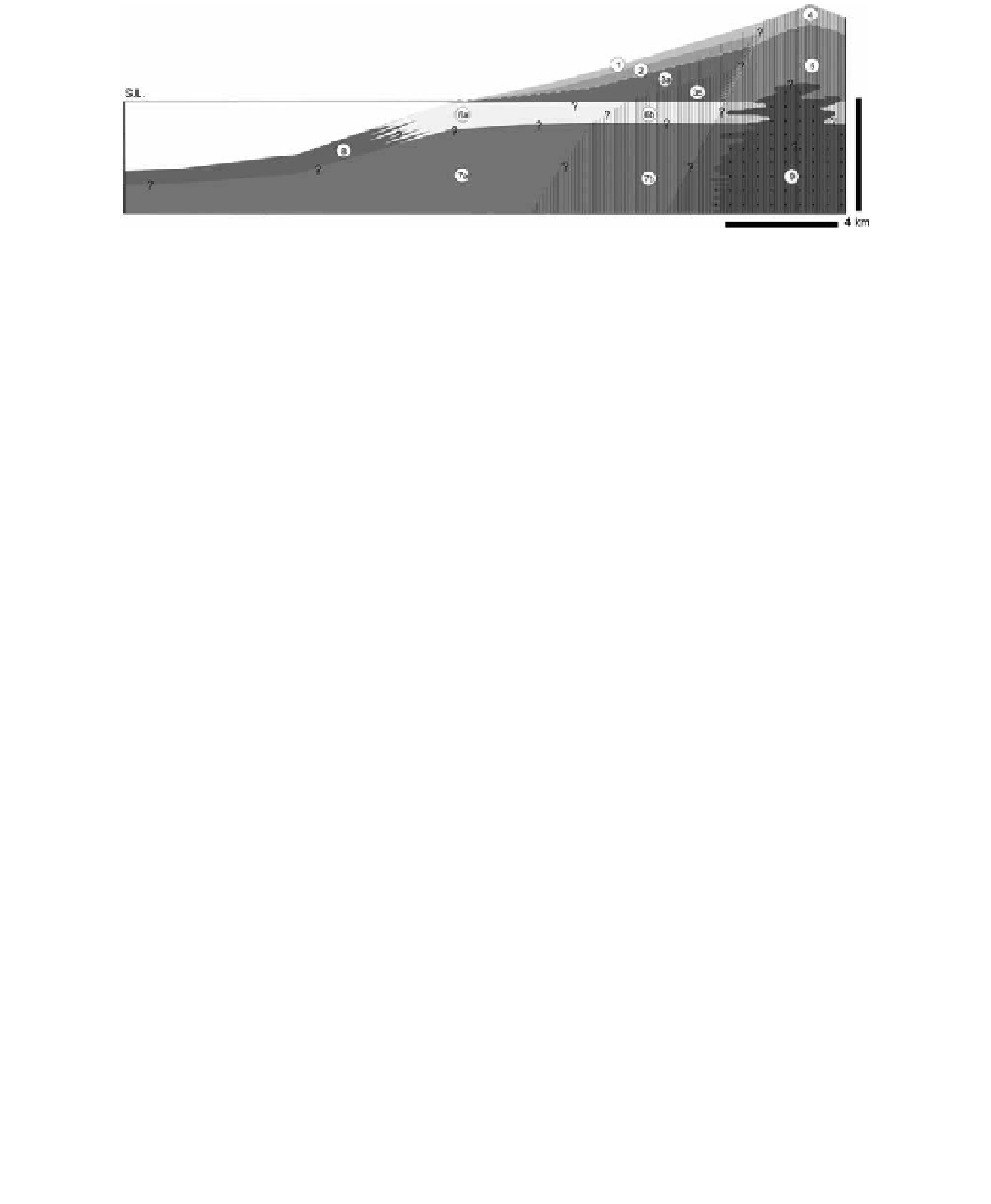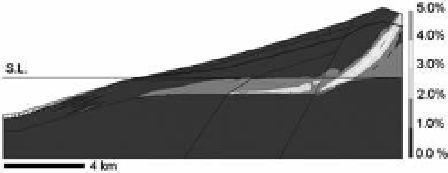Environmental Engineering Reference
In-Depth Information
Figure 2. simplified representative geological model of the flank of the volcanic edifice of Tenerife. numbers rep-
resents the different lithological units considered. 1, 2, 3a, 3b, units forming the flanks: lava layers predominant; 4, 5,
units forming the structural axis: pyroclastic deposits predominant; 6a, 6b, submarine rocks: hyaloclastites predomi-
nant; 7a, 7b, submarine rocks: pillow lavas predominant; 8, Fragmentary submarine deposits; 9, Plutonic complex:
dykes predominant. s.l.: sea level. Dashed line: water level. ?: uncertainties. The same scales horizontal and vertical.
6b. hyaloclastites (65%), pillow lavas (25%) and
dykes (10%).
7a. Pillow lavas (90%) and hyaloclastites (10%).
7b. Pillow lavas (85%), hyaloclastites (5%) and
dykes (10%).
Table 2. Geomechanical properties (c, φ, e) obtained
for the pre-failure edifice using hoek-Brown criterion.
γ
kn/m
3
c
MPa
φ
°
e
MPa
ν
-
Unit
8.
Fragmentary submarine deposits.
1
20.7
0.9
51
6756
0.30
9.
Dykes (90%) and pillow lavas (5%).
2
21.7
1.7
47
8921
0.30
3a
20.2
2.3
34
4204
0.29
3b
18.0
3.1
25
2779
0.29
4
18.0
0.9
33
2299
0.26
4
sTaBiliTY conDiTions oF GüÍMaR
anD la oRoTaVa PRe-FailURe
eDiFices
5
18.9
2.8
22
2056
0.26
6a
22.6
1.0
23
1012
0.33
6b
23.0
2.5
17
1176
0.32
7a
26.8
8.0
36
12023
0.28
stability analysis has been carried out in the pre-
failure edifices of Güímar and la orotava apply-
ing stress-strain methods. a first analysis has been
carried out using rock mass parameters obtained
shows the results of this analysis showing a large
deformation surface affecting the whole edifice. in
this case a factor of safety of 1.34 was obtained
applying c-φ reduction procedure.
a second stability analysis has been carried out
using deformability values for the hyaloclastites.
Figure 4 shows the results obtained. in this case,
the distribution of the maximum deformations
shows larger deformations affecting the hyaloclas-
tites and a new failure surface.
in this second analysis values of 0.1 MPa for
cohesion and 16° for angle of internal friction are
needed to reach limit equilibrium.
limit equilibrium methods have been also
applied showing similar results, Figure 5 (seisdedos,
2008).
although these results are still preliminary they
present significant potential failure surfaces that
are in accordance with the geomorphological and
geological features observed in Güímar and la
7b
27.2
11.4
34
13183
0.28
8
19.0
1.0
20
1000
0.30
9
27.6
13.2
33
10233
0.28
Figure 3. shear strains results using Table 2 properties
(maximum shear strain 4.3%). same scale horizontal and
vertical.
orotava valleys, as well as with the geomechanical
properties of the materials.
The importance of the hyaloclastites rocks has
been also pointed out on the stability of the hawaiian
volcano flanks (schiffman
et al
., 2006).


































